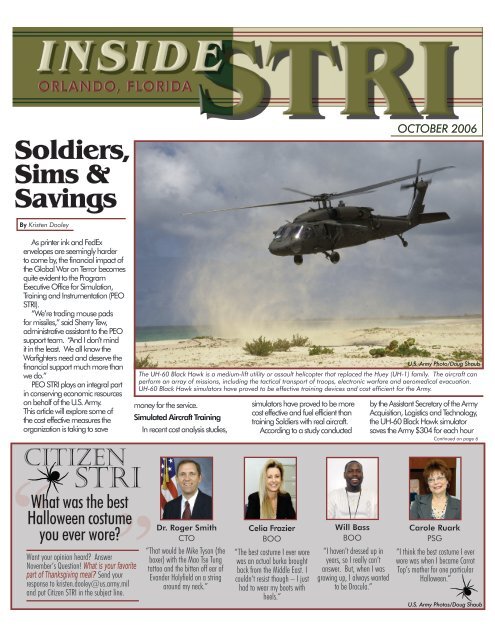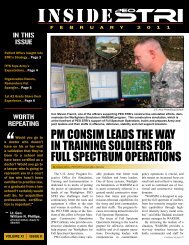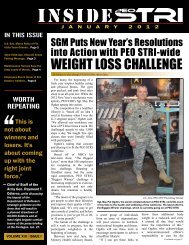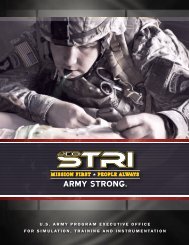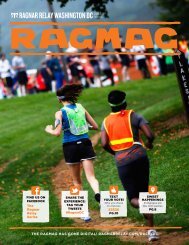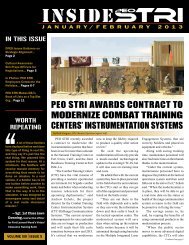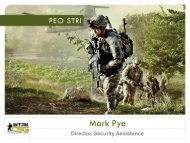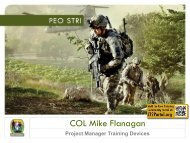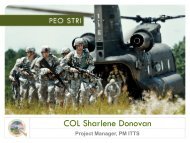Soldiers, Sims & Savings - PEO STRI - U.S. Army
Soldiers, Sims & Savings - PEO STRI - U.S. Army
Soldiers, Sims & Savings - PEO STRI - U.S. Army
You also want an ePaper? Increase the reach of your titles
YUMPU automatically turns print PDFs into web optimized ePapers that Google loves.
<strong>Soldiers</strong>,<br />
<strong>Sims</strong> &<br />
<strong>Savings</strong><br />
By Kristen Dooley<br />
As printer ink and FedEx<br />
envelopes are seemingly harder<br />
to come by, the financial impact of<br />
the Global War on Terror becomes<br />
quite evident to the Program<br />
Executive Office for Simulation,<br />
Training and Instrumentation (<strong>PEO</strong><br />
<strong>STRI</strong>).<br />
“We’re trading mouse pads<br />
for missiles,” said Sherry Tew,<br />
administrative assistant to the <strong>PEO</strong><br />
support team. “And I don’t mind<br />
it in the least. We all know the<br />
Warfighters need and deserve the<br />
financial support much more than<br />
we do.”<br />
<strong>PEO</strong> <strong>STRI</strong> plays an integral part<br />
in conserving economic resources<br />
on behalf of the U.S. <strong>Army</strong>.<br />
This article will explore some of<br />
the cost effective measures the<br />
organization is taking to save<br />
Citizen<br />
StRi<br />
What was the best<br />
Halloween costume<br />
you ever wore?<br />
Want your opinion heard? Answer<br />
November’s Question! What is your favorite<br />
part of Thanksgiving meal? Send your<br />
response to kristen.dooley@us.army.mil<br />
and put Citizen <strong>STRI</strong> in the subject line.<br />
OCTOBER 2006<br />
The UH-60 Black Hawk is a medium-lift utility or assault helicopter that replaced the Huey (UH-1) family. The aircraft can<br />
perform an array of missions, including the tactical transport of troops, electronic warfare and aeromedical evacuation.<br />
UH-60 Black Hawk simulators have proved to be effective training devices and cost efficient for the <strong>Army</strong>.<br />
money for the service.<br />
Simulated Aircraft Training<br />
In recent cost analysis studies,<br />
Dr. Roger Smith<br />
CTO<br />
“That would be Mike Tyson (the<br />
boxer) with the Mao Tse Tung<br />
tattoo and the bitten off ear of<br />
Evander Holyfield on a string<br />
around my neck.”<br />
simulators have proved to be more<br />
cost effective and fuel efficient than<br />
training <strong>Soldiers</strong> with real aircraft.<br />
According to a study conducted<br />
Celia Frazier<br />
BOO<br />
“The best costume I ever wore<br />
was an actual burka brought<br />
back from the Middle East. I<br />
couldn’t resist though – I just<br />
had to wear my boots with<br />
heels.”<br />
Will Bass<br />
BOO<br />
“I haven’t dressed up in<br />
years, so I really can’t<br />
answer. But, when I was<br />
growing up, I always wanted<br />
to be Dracula.”<br />
U.S. <strong>Army</strong> Photo/Doug Shaub<br />
by the Assistant Secretary of the <strong>Army</strong><br />
Acquisition, Logistics and Technology,<br />
the UH-60 Black Hawk simulator<br />
saves the <strong>Army</strong> $304 for each hour<br />
Continued on page 6<br />
Carole Ruark<br />
PSG<br />
“I think the best costume I ever<br />
wore was when I became Carrot<br />
Top’s mother for one particular<br />
Halloween.”<br />
U.S. <strong>Army</strong> Photos/Doug Shaub
Sept. 11, 2001 Remembered<br />
By Kristen Dooley<br />
On the five year<br />
anniversary of<br />
Sept. 11, the Naval<br />
Air Warfare Center Training<br />
Systems Division (NAWCTSD)<br />
held a commemorative<br />
ceremony to pay tribute to<br />
those who perished in the<br />
attacks on the World Trade<br />
Center, the Pentagon and<br />
United Flight 93. More than<br />
500 Team Orlando employees<br />
gathered to honor the heroes of<br />
Sept. 11 and those who serve<br />
in the Global War on Terror.<br />
“I believe this is an event<br />
we should never forget,” said<br />
Phillip Howell, public affairs<br />
director for NAWCTSD, who<br />
presided over the ceremony.<br />
“I wanted to remind our<br />
workforce that while many<br />
men and women are overseas<br />
fighting, we are relatively safe<br />
here.”<br />
The distinguished guests<br />
included U.S. Navy Capt. Steve<br />
Burris, commanding officer<br />
for NAWCTSD, U.S. <strong>Army</strong><br />
Col. Kevin Dietrick, deputy<br />
program executive officer for<br />
the Program Executive Office<br />
for Simulation Training and<br />
Instrumentation (<strong>PEO</strong> <strong>STRI</strong>),<br />
U.S. Air Force Col. Lou Olinto,<br />
Pictured left to right: Capt. Steve Burris, Col. Lou Olinto, Col. Kevin Dietrick,<br />
Col. Walter Augustin and Jim Crandall pause during a moment of silence to<br />
honor the victims of Sept. 11.<br />
2<br />
U.S. Navy Capt. Steve Burris (right) recognizes U.S. <strong>Army</strong> Lt. Col. Sterling<br />
Powell during the 9/11 commemorative ceremony. Lt. Col. Powell was in<br />
the Pentagon when American Airlines Flight 77 struck the building.<br />
commander of the Air Force<br />
Agency for Modeling and<br />
Simulation, and U.S. Marine<br />
Corps Col. Walter Augustin,<br />
program manager for Marine<br />
Corps Training Systems.<br />
“Today’s ceremony was<br />
an opportunity for all of us<br />
to reflect on the events of<br />
September 11, 2001, and the<br />
U.S. <strong>Army</strong> Photo/Doug Shaub<br />
progress that we have made<br />
as a nation in combating<br />
terrorism around the globe<br />
since that time,” said Dietrick.<br />
“I was impressed, but not<br />
surprised, by the size of the<br />
crowd that attended.”<br />
A delegate from each<br />
service participated in the<br />
event to represent their<br />
service’s contribution to the<br />
war on terror. In addition, the<br />
Orange County and Seminole<br />
County first response teams<br />
participated in the ceremony.<br />
A University of Central Florida<br />
policeman represented the<br />
institution as they are an<br />
integral part of Team Orlando.<br />
“While the nation remains<br />
at war, it is most important to<br />
remember those who have<br />
made the ultimate sacrifice<br />
for our nation. <strong>PEO</strong> <strong>STRI</strong>,<br />
along with the other services,<br />
raised the morale of <strong>Soldiers</strong>,<br />
Sailors, Airmen, Marines, Coast<br />
Guardsmen, government<br />
employees and contractors<br />
through today’s ceremony,”<br />
said Lt. Col. Sterling Powell,<br />
who was in the Pentagon at<br />
U.S. <strong>Army</strong> Photo/Doug Shaub<br />
the time of the attacks and<br />
represented <strong>PEO</strong> <strong>STRI</strong> in the<br />
ceremony. “We remember<br />
that day with emotions<br />
of fear and anger, yet it<br />
reminded America that<br />
the freedoms we take for<br />
granted also have a cost.<br />
Sometimes we have to pay<br />
the cost with our lives.”<br />
A moment of silence was<br />
taken at 8:46 a.m. which<br />
signified the time the first<br />
plane hit the north Twin<br />
Tower. The brief ceremony<br />
concluded with the choir<br />
singing “America the<br />
Beautiful.”<br />
“Thank you for<br />
remembering and honoring<br />
those who paid the ultimate<br />
price for the freedom we<br />
enjoy,” said Powell.
<strong>PEO</strong> <strong>STRI</strong> Celebrates<br />
Release of OneSAF<br />
The next generation of full spectrum computer<br />
generated forces has arrived, and it’s coming<br />
to a digital battlefield near you.<br />
By Heather L. Kelly<br />
The U.S. <strong>Army</strong> Program<br />
Executive Office for Simulation,<br />
Training and Instrumentation<br />
(<strong>PEO</strong> <strong>STRI</strong>) released the One<br />
Semi-Automated Forces<br />
(OneSAF) Objective System<br />
(OOS) software version 1.0<br />
Sept. 29.<br />
A release ceremony was held<br />
here Oct. 2 in Central Florida’s<br />
Research Park to mark the<br />
event.<br />
“This is a very special<br />
occasion, one that has been<br />
a long time in the making,”<br />
said Dr. James Blake, program<br />
executive officer for <strong>PEO</strong> <strong>STRI</strong>.<br />
“We now have a single solution<br />
to support all of the <strong>Army</strong>’s<br />
modeling and simulation<br />
domains.”<br />
The OOS was initially<br />
designed to reduce duplication<br />
of the <strong>Army</strong>’s modeling and<br />
simulation investments, create<br />
simulation interoperability and<br />
meet future force requirements,<br />
but its capabilities extend well<br />
past the original concept.<br />
“Not only will OOS be the<br />
central element of the <strong>Army</strong>’s<br />
embedded training efforts,<br />
it will also aid our sister<br />
services in their modeling<br />
and simulation activities,<br />
advance <strong>Army</strong> and Department<br />
of Defense training<br />
transformation initiatives, and<br />
improve value, quality and<br />
responsiveness to our primary<br />
customer -- the Warfighter,”<br />
Blake commented.<br />
As a Soldier who has served<br />
as both a user and developer<br />
of modeling and simulation<br />
products, Lt. Col. Rob Rasch,<br />
product manager for OneSAF,<br />
agreed.<br />
“Our trainers will utilize<br />
OneSAF to better prepare our<br />
<strong>Soldiers</strong>, units and staffs for the<br />
situations they may encounter<br />
as they fight our nation’s wars,”<br />
Rasch said. “After all, losing a<br />
simulated battle costs nothing<br />
compared to losing the lives<br />
of our <strong>Soldiers</strong> on the real<br />
battlefield.”<br />
Responsible for managing<br />
the implementation and<br />
distribution of the software,<br />
Rasch said OOS will be<br />
delivered to every brigade and<br />
battalion in the <strong>Army</strong>.<br />
“The system will become a<br />
common training component<br />
on every Future Combat<br />
Systems embedded training<br />
platform,” explained Rasch.<br />
“It will also provide tools to<br />
the Research, Development<br />
and Acquisition, Advanced<br />
Concepts and Requirements,<br />
and Training Exercise and<br />
Military Operations domains.”<br />
The OneSAF program<br />
has won numerous awards<br />
including a Department<br />
of Defense Top 5 Software<br />
Projects award for 2004 and<br />
2005. This year, the OneSAF<br />
team is competing for the 2006<br />
Florida Governor’s Award for<br />
Modeling and Simulation.<br />
“Initiative and innovation is<br />
what <strong>PEO</strong> <strong>STRI</strong> is all about,”<br />
said Blake. “It has allowed<br />
us to be a leader for change<br />
in the past and present, and<br />
now we are leaning forward<br />
to continue that trend into the<br />
future.”<br />
U.S. <strong>Army</strong> Photos/Doug Shaub<br />
Top: U.S. <strong>Army</strong> Maj. Federica King, assistant product manager for the<br />
One Semi-Automated Forces (OneSAF) program, proudly displays<br />
the modeling and simulation software that will be delivered to every<br />
brigade and battalion in the <strong>Army</strong>. After six years in development, the<br />
Program Executive Office for Simulation, Training and Instrumentation<br />
(<strong>PEO</strong> <strong>STRI</strong>) released the OneSAF Objective System (OOS) version 1.0<br />
Sept. 29.<br />
Bottom: The One Semi-Automated Forces Objective System (OOS)<br />
is evolutionary modeling and simulation software. The system<br />
creates interoperability between simulations and will be a common<br />
training component in all Future Combat Systems embedded training<br />
platforms.<br />
Headquartered in Orlando,<br />
Fla., <strong>PEO</strong> <strong>STRI</strong> provides<br />
interoperable training and<br />
testing solutions, program<br />
management and life-cycle<br />
support for the <strong>Army</strong>’s most<br />
advanced training systems<br />
around the world.<br />
3
<strong>PEO</strong> Taking Strides toward NSPS<br />
By Kristen Dooley<br />
Editor’s Note:<br />
This article is the first in a<br />
series that will detail <strong>PEO</strong><br />
<strong>STRI</strong>’s conversion to the<br />
NSPS. More details will be<br />
forthcoming as information is<br />
made available.<br />
T he<br />
Department of<br />
Defense (DOD)<br />
announced in<br />
July that it will implement the<br />
second phase (Spiral 1.2) of<br />
the National Security Personnel<br />
System (NSPS), a new civilian<br />
human resources system, to<br />
more than 66,000 employees<br />
between now and February<br />
2007.<br />
As directed by the<br />
Department of the <strong>Army</strong>, the<br />
Program Executive Office<br />
for Simulation, Training<br />
and Instrumentation (<strong>PEO</strong><br />
<strong>STRI</strong>) is taking steps toward<br />
that conversion, which will<br />
initially convert all NH-IV level<br />
personnel. Current plans are<br />
for the remainder of <strong>PEO</strong> <strong>STRI</strong><br />
employees to convert in fiscal<br />
year 2008.<br />
“Our goal is to train the<br />
trainers first,” said Dr. James<br />
Blake, program executive<br />
officer for <strong>PEO</strong> <strong>STRI</strong>. “The next<br />
step will be implementing it<br />
into the workforce.”<br />
Under the new<br />
classification structure,<br />
individuals will convert to<br />
NSPS without a loss of pay.<br />
The NSPS is comprised of<br />
three interrelated elements:<br />
pay bands, pay schedules and<br />
career groups. The pay band<br />
fits into a pay schedule and a<br />
pay schedule fits into one of<br />
four career groups.<br />
Every position fits into<br />
a career group – namely,<br />
standard, scientific and<br />
engineering, medical, and<br />
investigative and protective<br />
services. They are broad<br />
groupings of jobs that<br />
perform related work. For<br />
<strong>PEO</strong> <strong>STRI</strong> employees, all<br />
positions will fall into the<br />
standard and scientific and<br />
engineering career groups.<br />
Pay schedules combine<br />
similar types of work within<br />
each career group. They<br />
define and classify positions<br />
based on the nature of the<br />
work performed, career<br />
patterns, mission and job<br />
competencies.<br />
Much like the current<br />
Contribution-based<br />
Compensation and Appraisal<br />
System, NSPS groups positions<br />
based on a pay band within<br />
a specific pay schedule. The<br />
new pay scale establishes<br />
a pay-range for each pay<br />
band, with a minimum and<br />
maximum rate.<br />
“Pay is directly linked to<br />
performance and mission<br />
accomplishment,” said Mae<br />
Hazelton, personnel resources<br />
manager for <strong>PEO</strong> <strong>STRI</strong>. “A<br />
basic tenet of NSPS is to<br />
make meaningful distinctions<br />
The NSPS classification system architecture is comprised of three related elements - career groups,<br />
pay schedules, and pay bands. <strong>PEO</strong> <strong>STRI</strong> employee positions will be categorized in the Standard and<br />
Scientific and Engineering career groups.<br />
4<br />
Standard<br />
Pay Schedule<br />
PAY BAND 3<br />
PAY BAND 2<br />
PAY BAND 1<br />
CAREER GROUPS<br />
Scientific &<br />
Engineering<br />
Pay Schedule<br />
YA YB YC YD YE YF<br />
PAY BAND 3<br />
PAY BAND 2<br />
PAY BAND 1<br />
Medical<br />
Investigative<br />
& Protective<br />
Services<br />
in employee performance<br />
and to ensure employee<br />
development with ongoing<br />
feedback and dialogue.”<br />
NSPS is a management<br />
system that compensates<br />
employees based on their<br />
performance and contribution<br />
to the organization.<br />
“NSPS is not about<br />
personnel rules and policies,<br />
rather it is about driving<br />
culture change away from a<br />
focus on activities and levels<br />
of effort and toward a culture<br />
of performance and results,”<br />
stated Francis J. Harvey,<br />
secretary of the U.S. <strong>Army</strong>.<br />
“We can and must leverage<br />
flexibilities in NSPS to<br />
execute our national security<br />
mission.”<br />
According to the NSPS<br />
website, when an employee’s<br />
performance and work are<br />
aligned with organizational<br />
goals and the DOD’s<br />
mission, his or her value to<br />
the organization is enhanced.<br />
The performance of an<br />
employee is rewarded by an<br />
increase in salary, a bonus or<br />
a combination of both.<br />
“I encourage all <strong>PEO</strong> <strong>STRI</strong><br />
employees to take the NSPS<br />
online course,” said Hazelton.<br />
“The transition management<br />
team will use appropriate<br />
venues – town hall meetings,<br />
brown-bag information<br />
sessions and a sharepoint site<br />
– to involve the workforce in<br />
planning and implementation<br />
guidance.”<br />
Employees have access to<br />
training materials, including<br />
the NSPS 101 course located<br />
on the NSPS website at www.<br />
cpms.osd.mil/nsps/nsps101/<br />
nsps/index.htm.<br />
“The concept is the same<br />
as our current system: people<br />
making a difference should<br />
be rewarded,” said Blake.
Cost <strong>Savings</strong>... continued from front page<br />
of aircraft training.<br />
To illustrate, the UH-60 Black<br />
Hawk consumes 600 liters of fuel per<br />
hour which equates to approximately<br />
$314 per hour. The UH-60 Black<br />
Hawk simulator uses 144.7 kilo<br />
volt-amps of electricity per hour which<br />
costs about $10.<br />
Dr. Roger Smith, chief scientist for<br />
<strong>PEO</strong> <strong>STRI</strong>, said the organization has<br />
recently deployed new UH-60 Black<br />
Hawk simulators that will reduce<br />
electricity consumption by nearly<br />
30-percent. Cost-saving data has yet<br />
to be collected due to the newness of<br />
the deployment.<br />
The Common Driver Trainer/Stryker Variant (CDT/SV) provides initial and sustainment driver training at<br />
training institutions and operational installations.<br />
Other simulated helicopters,<br />
including the AH-64A Apache,<br />
CH-47D Chinook, and the UH-<br />
1H Iroquois (Huey), save the <strong>Army</strong><br />
a significant amount of money in<br />
relation to the cost of training in the<br />
actual aircraft. The simulators cost<br />
$500 per hour whereas training in<br />
the real helicopter can cost as much<br />
as $7,503 per hour.<br />
In addition, military training<br />
exercises cut costs when using<br />
simulated aim, fire and guided<br />
weapons. The simulated weapons<br />
are cost-free as compared to real<br />
weapons – namely, the hellfire missile<br />
6<br />
at $75,000 each, the hydra rocket at<br />
$5,500 each and the 30mm round<br />
at $230 each.<br />
Common Driver Trainer/Stryker<br />
Variant (CDT/SV)<br />
The primary mission of the<br />
CDT/SV, a program under Product<br />
Manager Ground Combat Tactical<br />
Trainer (PM GCTT), is to provide<br />
driver training at operational<br />
institutions and training installations.<br />
The program, which simulates <strong>Army</strong><br />
tactical vehicles, has resulted in more<br />
than $28 million in cost savings over<br />
the past 10 years.<br />
“The CDT program was born<br />
of the necessity to save money in<br />
repetitive procurements of unique<br />
vehicle platform driver trainers,”<br />
said Robert Raisler, deputy product<br />
manager for PM GCTT.<br />
The simulated vehicle is<br />
significantly more cost effective than<br />
the actual means of transportation.<br />
A CDT/SV costs $800,000 as<br />
compared to an actual Stryker, which<br />
can cost up to $4.13 million per<br />
vehicle.<br />
The simulator consists of a vehicle<br />
cab, instructor/operator station,<br />
After Action Review (AAR) station,<br />
visual system, motion system and a<br />
computational system.<br />
The instructor can select a visual<br />
scene, view the scene, introduce<br />
malfunctions and emergency control<br />
situations, monitor each trainee’s<br />
performance and provide recorded<br />
AAR feedback.<br />
“Re-host and upgrade costs<br />
are reduced based on a common<br />
interchangeable cab configuration<br />
and electric motion platform design,”<br />
said Raisler. “For all common<br />
systems, software and hardware<br />
configurations are compatible<br />
and terrain databases are<br />
interchangeable.”<br />
Common Gunnery Architecture<br />
(CGA)<br />
CGA, a Project Manager<br />
Combined Arms Tactical Trainer (PM<br />
CATT) initiative, is the standardization<br />
of all virtual gunnery training systems<br />
to a single baseline which allows for<br />
long-term growth potential in training<br />
capabilities.<br />
“In the absence of CGA, the<br />
U.S. <strong>Army</strong> and U.S. Marine Corps<br />
will continue to pay redundant<br />
developmental and lifecycle support<br />
costs for four distinct baselines,” said<br />
Maj. William Brennan, assistant<br />
product manager for PM GCTT.<br />
“Within CGA compliant and<br />
interconnected training devices, crews<br />
of Abrams, Bradley, Stryker and<br />
FCS [Future Combat Systems] series<br />
vehicles will be able to interoperate in<br />
a standardized, realistic environment<br />
for training and mission rehearsal.”<br />
In August of 2004, a <strong>PEO</strong> <strong>STRI</strong><br />
integrated product team validated<br />
the cost-benefit analysis of CGA. The<br />
analysis projected a cost savings of<br />
$66.4 million over the next 10 years.<br />
According to an <strong>Army</strong> Audit<br />
Agency report issued on July 20,<br />
2006, the <strong>Army</strong> could achieve a cost<br />
avoidance of $53.4 million between<br />
fiscal years 2008 and 2013 if it<br />
converts gunnery training devices<br />
to CGA-based software. Over a<br />
15-year period, the <strong>Army</strong> could<br />
realize an additional $111.8 million<br />
in savings.<br />
“CGA provides timely training to<br />
<strong>Soldiers</strong> with flexible and adaptive<br />
gunnery solutions,” said John<br />
Kirch, business manager for Project<br />
Manager Constructive Simulations<br />
(PM ConSim) who directs the One<br />
Semi-Automated Force Objective<br />
System. “It minimizes total lifecycle<br />
costs and risks, and bridges the gap<br />
with FCS but is not dependent upon<br />
the FCS fielding schedule.”<br />
Battlefield Effects Simulator (BES)<br />
The BES system, a product of<br />
Project Manager Training Devices<br />
(PM TRADE), simulates the flash<br />
and bang of a weapon’s discharge<br />
and imitates the impact of force-ontarget,<br />
live-fire training. The BES,<br />
a five-year contract, will result in a<br />
cost avoidance of approximately<br />
40-percent.<br />
The simulator consists of three<br />
components – the Omega 60<br />
simulator system, the M34 cartridge,<br />
and the M35 cartridge. The Omega<br />
60 simulator system is a device<br />
that ignites pyrotechnic cartridges<br />
on command. The M34 cartridge<br />
produces the flash and sound of tank<br />
gunfire. The M35 cartridge produces<br />
the flash and sound of a round on<br />
an armor target.<br />
“Significant cost avoidance shall<br />
be realized through lower prices<br />
of launchers, Omega 60, and<br />
cartridges, M34 and M35,” said<br />
V. David Mize, BES project director.<br />
“Typically, launchers are a one time<br />
purchase and the cartridges are<br />
consumable, therefore the primary
cost avoidance is realized with the<br />
cartridges.”<br />
Live Training Transformation<br />
(LT2)<br />
PM TRADE’s Common Training<br />
Instrumentation Architecture (CTIA)<br />
provides a product-line architecture<br />
that will implement LT2, which is an<br />
<strong>Army</strong>-wide initiative to develop a livetraining<br />
range product line.<br />
“A preliminary analysis performed<br />
on software reusability of two LT2<br />
main products shows a potential<br />
cost avoidance of approximately<br />
$18 million,” said Angel Matta,<br />
operations research systems analyst<br />
for <strong>PEO</strong> <strong>STRI</strong>.<br />
Cost savings are achieved through<br />
reusable components, a common set<br />
of solutions and lifecycle sustainment<br />
for the LT2 family of training systems.<br />
“The LT2 product line strategy<br />
is required to synergize training,<br />
instrumentation, targets and tactical<br />
engagement simulation systems to<br />
ensure the effectiveness of training<br />
during peacetime, mobilization,<br />
mission rehearsal in-theater and<br />
during deployed military operations,”<br />
said Matta.<br />
Contamination Avoidance<br />
Detector Suite (CADTS)<br />
The Instrument Management<br />
Office within the Project Manager<br />
Instrumentation Targets and Threat<br />
Systems (PM ITTS) initiated CADTS.<br />
The project enhances the capability<br />
of the test and evaluation community<br />
to evaluate chemical and biological<br />
detector systems.<br />
“The capabilities developed by<br />
the CADTS project not only provide<br />
more realistic environments in<br />
evaluating the detector systems, but<br />
also provide efficiencies that result in<br />
cost savings to the detector program<br />
managers,” said Eddie Meadows,<br />
deputy product manager for CADTS.<br />
The Biological Agent Irradiation<br />
Facility (BAIF) inactivates biological<br />
agents so they are not harmful and<br />
can be used in field testing. Before<br />
the installation of the facility at<br />
Dugway Proving Ground, Utah, the<br />
live agents had to be shipped out for<br />
irradiation and then back to the test<br />
site.<br />
“After Sept. 11, the shipment<br />
of any weaponized agent had to<br />
be a secured shipment at a cost<br />
of $35,000 per shipment,” said<br />
Meadows. “There has been a<br />
cost avoidance to the customer of<br />
$7 million since the BAIF became<br />
functional in 2003.”<br />
Ground Targets<br />
The Targets Management Office<br />
(TMO) within PM ITTS met the<br />
requirements of the Guided Multiple<br />
Launch Rocket System (GMLRS), a<br />
type of rocket artillery, and saved the<br />
<strong>Army</strong> $2.15 million.<br />
GMLRS required a combat vehicle<br />
(BM-21) and a 122mm gun that fires<br />
a range of ammunition, including D-<br />
30s. In addition, the GMLRS needed<br />
an SA-6 site, an air defense artillery<br />
The Biological Agent Irradiation Facility (BAIF) inactivates live<br />
biological agents to make them safe for field tests and open air<br />
release. The facility essentially kills the active organism so the<br />
agent is no longer harmful to humans.<br />
threat location where information is<br />
communicated to allow long range<br />
defense from incoming air artillery.<br />
Since the targets are used for<br />
destructive tests, the use of actual<br />
hardware was cost prohibitive;<br />
therefore the TMO modified and<br />
provided existing military trucks – ZIL<br />
131, ZIL 157 and URAL 375.<br />
“Working with the customer and<br />
our sources, the TMO was able to<br />
obtain a surplus of U.S. M114A2<br />
howitzers [medium-sized, towed<br />
artillery pieces] for use as surrogate<br />
targets,” said Robbin Finley, project<br />
director of GMLRS. “The howitzers<br />
were modified with an extended tube<br />
to visually represent a threatening<br />
D-30.”<br />
Seven surrogate targets were<br />
purchased at $12,000 each for a<br />
total cost of $84,000. The cost of<br />
an actual D-30 is $135,000, which<br />
saved $861,000 in total.<br />
The TMO modified existing<br />
fleet trucks with fabricated launch<br />
assemblies to imitate a BM-21. These<br />
surrogates were developed for a cost<br />
of $16,670 per vehicle, compared<br />
to $100,000 for an actual BM-21.<br />
This resulted in a cost avoidance of<br />
$500,000 for six vehicles.<br />
The TMO used plastic targets<br />
to meet the needs of the SA-6 site<br />
which cost $75,000. Compared<br />
to the $860,000 for actual threat<br />
assets, TMO saved the U.S. <strong>Army</strong><br />
$785,000.<br />
As a result, the TMO saved more<br />
than $2 million for 20 ground target<br />
vehicles.<br />
“The TMO works consistently to<br />
provide targets to customers in the<br />
most cost effective way while still<br />
meeting all test requirements,” said<br />
Finley.<br />
Intelligence Modeling and<br />
Simulation for Evaluation<br />
(IMASE) Scenario Generation<br />
Tool (ISGT)<br />
ISGT reduces the testscenario<br />
development time from<br />
approximately 24 months to fourmonths,<br />
thus significantly reducing<br />
costs. Over the last year, ISGT has<br />
yielded a cost avoidance of more<br />
than $1.2 million.<br />
“ISGT will further reduce the<br />
scenario-generation time and cost<br />
through the reuse of scenarios<br />
already developed, a more<br />
enhanced automated capability, and<br />
more training and familiarization of<br />
the tool,” said Paul Morley, project<br />
director for ISGT.<br />
According to the U.S. <strong>Army</strong><br />
Test and Evaluation Center, the<br />
average test-scenario is comprised<br />
of 150,000 entities and takes place<br />
over an 18-month to 24-month<br />
period.<br />
The Threat Systems Management<br />
Office (TSMO) within PM ITTS<br />
developed a tool that provides<br />
enhanced planning and execution<br />
of scenarios for operational testing<br />
of Intelligence Electronic Warfare<br />
systems. The product automates<br />
threat scenario development<br />
capabilities to support operational<br />
testing. The ISGT reduces test<br />
preparation and execution costs<br />
through the automation.<br />
“TSMO is using an evolutionary<br />
approach to provide automated<br />
capabilities to the war-gamer for<br />
scenario generation,” said Morley.<br />
Fielding Warfighters’ Simulation<br />
(WARSIM)<br />
WARSIM, a software simulation<br />
system acquired by PM ConSim,<br />
creates a realistic environment for<br />
command and staff training for the<br />
<strong>Army</strong> and Joint Commanders. The<br />
U.S. <strong>Army</strong> saved nearly $500,000 in<br />
fielding the system.<br />
“Initially, WARSIM software ran<br />
with the Solaris operating system and<br />
continued on page 9<br />
7
Many of us have<br />
laughed at the television<br />
commercials where little<br />
old ladies sound like they<br />
are talking like bikers<br />
or a strong man lifting<br />
weights sounds like a<br />
young woman. The<br />
commercial wants you<br />
to believe that that these<br />
fictional people have<br />
suffered identity theft and<br />
are talking like the people<br />
who perpetrated the<br />
crime. However, identity<br />
theft is not funny. Identity<br />
theft is actually one of the<br />
most frightening and least<br />
understood problems for<br />
many people today.<br />
What is “identity theft”?<br />
Identity theft occurs when<br />
someone appropriates<br />
your personal information<br />
without your knowledge<br />
to commit fraud or theft.<br />
In plain terms, this means<br />
that someone gets your<br />
name, address, social<br />
security number and credit<br />
card or other information,<br />
and uses them to run up<br />
big bills, pretending they<br />
are actually you. Many<br />
times, you might not find<br />
out about the theft for<br />
months. By the time you<br />
discover the fraudulent<br />
charge or bill, you have<br />
ruined credit and the bill<br />
collectors are hounding<br />
you.<br />
How does this type of<br />
8<br />
What To Do If You Might Be a<br />
Victim of Identity Theft<br />
thing happen? ANYONE<br />
who has access to the<br />
basic information needed<br />
to apply for credit, or even<br />
telephone or cell phone<br />
service, could potentially<br />
use that information to steal<br />
your identity. This includes<br />
people like the clerk in the<br />
store where you applied for<br />
a credit card, your landlord,<br />
or the cashier you handed<br />
your credit card to.<br />
What should you do if you<br />
suspect that this may have<br />
happened to you? The Fair<br />
Credit Reporting Act gives<br />
you specific rights when you<br />
suspect that your identity<br />
was stolen.<br />
First, call one of the<br />
three nationwide consumer<br />
reporting agencies and<br />
request that they place a<br />
“fraud alert” in your file. A<br />
fraud alert is good for 90<br />
days and makes it more<br />
difficult for someone to<br />
get credit in your name<br />
because it tells creditors to<br />
follow certain procedures<br />
to protect you. Once you<br />
notify one of the agencies,<br />
that agency must notify<br />
the other two regarding<br />
the fraud alert. The three<br />
agencies are: Equifax,<br />
Experian, and TransUnion.<br />
You may also request an<br />
“extended alert” that lasts<br />
for seven years. If you ask<br />
for the extended alert, you<br />
must at least provide a copy<br />
of an “identity<br />
theft report” that<br />
you have filed<br />
with a federal,<br />
state, or local<br />
law enforcement<br />
agency.<br />
Second, once<br />
you file the initial<br />
fraud alert, you also<br />
have the right to a free<br />
copy of the information<br />
in your file from all three<br />
nationwide agencies. An<br />
extended alert entitles you<br />
to two free copies of your<br />
file in the following 12<br />
months. The additional<br />
opportunity to obtain your<br />
credit file will help you<br />
to monitor your accounts<br />
over time to<br />
By Laura Cushler<br />
help you see<br />
if someone<br />
opened a<br />
fraudulent<br />
account in<br />
your name<br />
or reported<br />
a change in<br />
your address.<br />
You are also<br />
entitled to a<br />
free copy of<br />
your file every<br />
year if you<br />
believe it has<br />
inaccurate<br />
information<br />
due to any<br />
kind of fraud, including<br />
identity theft.<br />
Third, you have the right<br />
to a copy of any documents<br />
relating to fraudulent<br />
transactions made or<br />
accounts opened using<br />
your personal information.<br />
You also have the right<br />
to obtain information<br />
from a debt collector. For<br />
example, if you request<br />
it, a debt collector must<br />
provide you with certain<br />
information about a<br />
debt, if you believe was<br />
incurred in your name by<br />
Consumer Reporting<br />
Agencies<br />
Equifax:<br />
1-800-525-6285<br />
www.equifax.com<br />
Experian:<br />
1-888-397-3742<br />
www.experian.com<br />
TransUnion:<br />
1-800-680-7289<br />
www.transunion.com<br />
an identity thief. The types<br />
of information they must<br />
provide include the name of<br />
the creditor and the amount<br />
of the debt.<br />
Fourth, if you believe<br />
information in your credit<br />
file resulted from identity<br />
theft, you have the right<br />
to ask that consumer<br />
reporting agencies block<br />
that information from your<br />
file. You might request a<br />
block, for example, if an<br />
identity thief runs bills up<br />
in your name and those<br />
outstanding debts appear<br />
on your credit report.<br />
Once a debt resulting from<br />
identity theft is blocked,<br />
a person or business with<br />
notice of the<br />
block may<br />
not sell,<br />
transfer, or<br />
assign the<br />
debt to a<br />
collection<br />
agency.<br />
You may<br />
also prevent<br />
businesses<br />
from<br />
reporting<br />
information<br />
about you<br />
to consumer<br />
reporting<br />
agencies if<br />
you believe<br />
the information is a result<br />
of identity theft. In order<br />
to do so, you must send<br />
your request to the business<br />
address that specifically<br />
reports the information to<br />
the consumer reporting<br />
agency.<br />
For more information<br />
on identity theft and your<br />
rights under the Fair Credit<br />
Reporting Act, see www.<br />
consumer.gov/idtheft and<br />
www.ftc.gov/credit.<br />
Please contact Laura<br />
Cushler, Associate Counsel,<br />
<strong>PEO</strong> Legal Office x3509
Cost <strong>Savings</strong>... continued from page 7<br />
Fujitsu/Sun servers, which were not<br />
cost effective,” said Kirch. “Through<br />
an analysis to reduce hardware cost<br />
to field WARSIM, it was determined<br />
to port the WARSIM software from<br />
Solaris to the Linux operating system.<br />
By successfully completing this port, it<br />
gave the program flexibility to run on<br />
less expensive hardware servers.”<br />
Consolidated Oracle Buy<br />
PM ConSim purchased 170<br />
Oracle database enterprise<br />
processor licenses and in doing so,<br />
Ricardo Escobar<br />
PSG<br />
Ayana Graham<br />
PSG<br />
Patricia Hyland<br />
PSG<br />
Felix Marrero<br />
PSG<br />
Terry Gulley<br />
PSG<br />
Darrell Wright<br />
PM ITTS<br />
Mona Crissey<br />
PM CATT<br />
Leo Belleville<br />
PSG<br />
U P C O M i n G e V e n t S<br />
OCT 6<br />
OCT 9<br />
OCT 18<br />
OCT 19<br />
OCT 29<br />
OCT 31<br />
saved more than $5.5 million.<br />
“The GSA [U.S. General Services<br />
Administration]<br />
schedule price<br />
was estimated to<br />
be approximately<br />
$7 million,”<br />
said Kirch. “PM<br />
ConSim went to<br />
the U.S. <strong>Army</strong><br />
Small Computer<br />
Program to<br />
see if we could<br />
participate in a consolidated buy.”<br />
As part of a consolidated buy, PM<br />
ConSim’s actions resulted in a 62.5percent<br />
savings<br />
When dealing with<br />
potentially life<br />
threatening situations,<br />
the cost of simulator<br />
training is well worth<br />
the investment,<br />
said Raisler.<br />
from the GSA<br />
schedule prices.<br />
Saving<br />
through<br />
Simulation<br />
“Training<br />
in simulators<br />
offers a virtually<br />
risk-free<br />
environment while still providing a<br />
By: Marge Hadbavny<br />
When conducting business via<br />
e-mail, take the following points<br />
into consideration:<br />
It is perfectly acceptable, and<br />
in fact preferable, to conduct<br />
business transactions by e-mail.<br />
Highly important<br />
correspondences should not be<br />
sent online because e-mail is not<br />
reliable enough.<br />
Humor can be misconstrued by<br />
the receiver, so use caution when<br />
making witty observations or<br />
remarks in an e-mail.<br />
Reread e-mails multiple times<br />
before sending it because<br />
misspellings and incorrect<br />
grammar will reflect poorly on<br />
you.<br />
Be careful when referencing<br />
sensitive subjects because you do<br />
not want to offend a colleague<br />
or give someone the<br />
wrong impression.<br />
Reference: “The<br />
Fabulous Girl’s Guide<br />
to Decorum,” by Kim<br />
Izzo and Ceri Marsh<br />
(2001)<br />
realistic experience for the user,” said<br />
Raisler.<br />
According to a 1997 publication<br />
by Jesse Orlansky, simulators offer<br />
a tremendous cost advantage<br />
over real world training noting<br />
that “researchers have found that<br />
simulator training costs one-tenth<br />
of the investment of actual field<br />
exercises.”<br />
“When dealing with potentially<br />
life threatening situations, the cost of<br />
simulator training is well worth the<br />
investment,” said Raisler.<br />
Business E-mail Etiquette<br />
9
Team Orlando in Pictures<br />
Officers from the<br />
Royal Thai Armed<br />
Forces visited the<br />
Program Executive Office<br />
for Simulation, Training<br />
and Instrumentation<br />
in September for an<br />
overview briefing on<br />
Military Operations<br />
on Urbanized Terrain.<br />
Pictured from left to<br />
right: Maj. Mike Snook,<br />
joint U.S. military<br />
advisory group for<br />
Thailand, and Thai<br />
officers -- Lt. Gen.<br />
Chaipat, Maj. Gen.<br />
Tarnchaiyan, Lt. Gen.<br />
Kanchanawat and<br />
Capt. Sanyalak.<br />
The Joint<br />
Advanced Distributed<br />
Learning Co-Laboratory (JADL Co-Lab) held their<br />
annual Implementation Fest at Disney’s Yacht & Beach Club to highlight the quality of<br />
training and education provided to America’s Warfighters. The three-day conference included presentations by<br />
distinguished military officers and Dan Gardner, director of Readiness and Training Policy and Programs for the Office<br />
of the Secretary of Defense. Many significant issues facing our military today were identified, such as problems with<br />
language barriers and cultural differences. Pictured left to right: Jean Burmester, director, JADL Co-Lab in Orlando,<br />
Fla., Paul Jesukiewicz, deputy director of ADL Initiative, Office of the Secretary of Defense, Joe Camacho, program<br />
manager for Joint Knowledge Development and Distribution Capability, Dan Gardner, and Robert Wisher, director of<br />
ADL Initiative, Office of the Secretary of Defense.<br />
11
Inside <strong>STRI</strong> is an authorized publication for military<br />
and civilian members of the U.S. <strong>Army</strong> Program Executive<br />
Office for Simulation, Training and Instrumentation,<br />
Orlando, Fla. 32826. Inside <strong>STRI</strong> is published under<br />
the authority of AR 360-1 and applies the Associated<br />
Press Stylebook industry standard.<br />
Contents of Inside <strong>STRI</strong> are not necessarily the<br />
official views of, or endorsed by, the U.S. Government,<br />
Department of Defense, Department of the <strong>Army</strong>, or<br />
<strong>PEO</strong> <strong>STRI</strong>.<br />
Editorial material for publication should be submitted<br />
to <strong>PEO</strong> <strong>STRI</strong> Public Affairs Office, 12351 Research<br />
Parkway, Orlando, Fla. 32826. The PAO reserves the<br />
right to edit all material submitted for publication.<br />
For more information about <strong>PEO</strong> <strong>STRI</strong> or to view<br />
Inside <strong>STRI</strong> online, visit our Web site at www.peostri.<br />
army.mil<br />
12<br />
Editors:<br />
Kristen Dooley<br />
Staff Writer and Editor<br />
Kristen.dooley@us.army.mil<br />
Heather Kelly<br />
Editor-in-Chief<br />
Heather.l.kelly1@us.army.mil<br />
Layout and Design:<br />
Dwain Fletcher Company<br />
U.S. <strong>Army</strong> Photo/Doug Shaub<br />
Federica Federica “Freddie” “Freddie” King<br />
King<br />
Maj. Federica<br />
“Freddie” King is<br />
neither the first in her<br />
family to serve the<br />
nation, nor is she the last.<br />
“I am an <strong>Army</strong> brat,” said King,<br />
who joined the <strong>Army</strong> in 1984 as<br />
an enlisted Soldier. “My father<br />
and oldest sister<br />
retired from the<br />
<strong>Army</strong> and my brother<br />
retired from the Navy.<br />
Service to the country<br />
became a family<br />
tradition.”<br />
King’s son, Pfc.<br />
Kaitron S. Bryant,<br />
followed in his<br />
mother’s footsteps<br />
and enlisted in the<br />
<strong>Army</strong> after a year<br />
at Central Florida<br />
Community College.<br />
“I joined the <strong>Army</strong> because<br />
it was a great opportunity to<br />
receive money for college and<br />
get the training that I need to<br />
someday own my own dental<br />
practice,” said Bryant who joined<br />
the military in 2005 and currently<br />
assists in providing dental care to<br />
<strong>Soldiers</strong> at Fort Campbell, Ky.<br />
Bryant said King always<br />
reminded him that the <strong>Army</strong> is<br />
a great place to be, but also<br />
The <strong>PEO</strong> <strong>STRI</strong><br />
Employee<br />
Employee<br />
Spotlight<br />
Family Makes the <strong>Army</strong> a Tradition<br />
By Kristen Dooley<br />
allowed him to pursue his<br />
dreams.<br />
“I advised my son to explore<br />
all of his options and then make<br />
his own decision. If he joined<br />
the military, I wanted it to be<br />
because that is what he wanted<br />
to do and not what he believed<br />
I wanted him to do,”<br />
said King. “He told<br />
me college was not<br />
where he wanted to<br />
be. He wanted to be<br />
a Soldier.”<br />
King said the best<br />
advice she offered<br />
her son was to work<br />
hard and put forth<br />
110-percent every<br />
day.<br />
“She is a great<br />
mother, role model,<br />
and <strong>Army</strong> officer,”<br />
said Bryant about his mother.<br />
Bryant said he would like his<br />
children to follow the family<br />
tradition and serve in the<br />
military.<br />
“It would be great for my kids<br />
to join the military because of the<br />
opportunities the <strong>Army</strong> provides,”<br />
said Bryant. “However, whatever<br />
they decide to do in life, I just<br />
want my children to be happy<br />
with the decision they make.”


